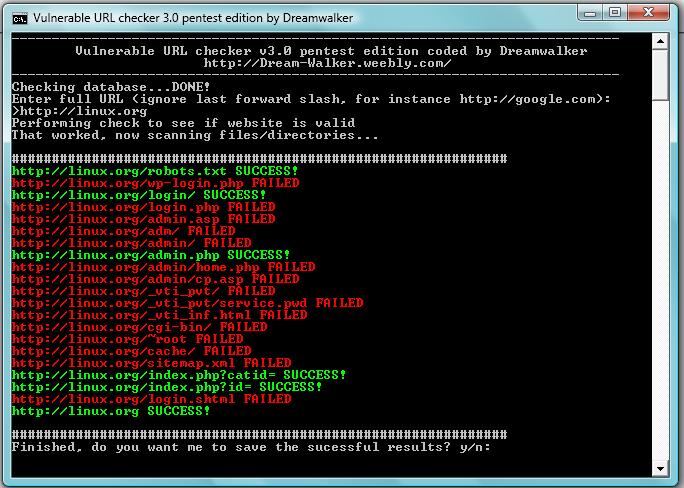This site is the archived OWASP Foundation Wiki and is no longer accepting Account Requests.
To view the new OWASP Foundation website, please visit https://owasp.org
Difference between revisions of "OWASP URL Checker"
From OWASP
Mr Craig Fox (talk | contribs) |
Mr Craig Fox (talk | contribs) m (minor tweak) |
||
| (3 intermediate revisions by 2 users not shown) | |||
| Line 1: | Line 1: | ||
=Main= | =Main= | ||
| − | <div style="width:100%;height:160px;border:0,margin:0;overflow: hidden;">[[ | + | <div style="width:100%;height:160px;border:0,margin:0;overflow: hidden;">[[Image:OWASP Inactive Banner.jpg|800px| link=https://www.owasp.org/index.php/OWASP_Project_Stages#tab=Inactive_Projects]] </div> |
{| style="padding: 0;margin:0;margin-top:10px;text-align:left;" |- | {| style="padding: 0;margin:0;margin-top:10px;text-align:left;" |- | ||
| Line 19: | Line 19: | ||
==Description== | ==Description== | ||
| − | This tool will check a user defined website for potentially exploitable/ vulnerable URL's by comparing them against the URL extensions in the database, for instance if your target is http://google.com and in the database you have /wp-login.php it would then check if: http://google.com/wp-login.php is available on that site by checking the response. It's a form of of scanning to help you exploit and find weaknesses within the web server. The first time you run the tool it will create a database "restuls.txt" for you, and add a few URL parameters to get you started. But you can add to or change the database as much as you wish and therefore, it's as powerful as you'd like it to be. It gives you real time feedback and the option to save all the successful results. You'll also be happy to know it's open source, and I've also included a win32 compiled version (requires .NET 3.5+). | + | This tool will check a user defined website for potentially exploitable/ vulnerable URL's by comparing them against the URL extensions in the database, for instance if your target is http://google.com and in the database you have /wp-login.php it would then check if: http://google.com/wp-login.php is available on that site by checking the response. It's a form of of scanning to help you exploit and find weaknesses within the web server. The first time you run the tool it will create a database "restuls.txt" for you, and add a few URL parameters to get you started. But you can add to or change the database as much as you wish and therefore, it's as powerful as you'd like it to be. It gives you real time feedback and the option to save all the successful results. You'll also be happy to know it's open source, and I've also included a win32 compiled version (requires .NET 3.5+). |
| − | |||
==Licensing== | ==Licensing== | ||
| Line 41: | Line 40: | ||
[mailto:craig.fox@owasp.org Craig Fox (OWASP email)] | [mailto:craig.fox@owasp.org Craig Fox (OWASP email)] | ||
| − | |||
| − | |||
| − | |||
| − | |||
| − | |||
| − | |||
| − | |||
| − | |||
| − | |||
| − | |||
| − | |||
== Quick Download == | == Quick Download == | ||
| − | |||
[http://www.softpedia.com/dyn-postdownload.php/fe910f128856e49ea01d2e3fcb37a1bc/53a9f7bf/3c191/4/1 Softpedia Secure Download (US)] | [http://www.softpedia.com/dyn-postdownload.php/fe910f128856e49ea01d2e3fcb37a1bc/53a9f7bf/3c191/4/1 Softpedia Secure Download (US)] | ||
| Line 61: | Line 48: | ||
| − | |||
| − | |||
Latest revision as of 17:44, 17 December 2018




